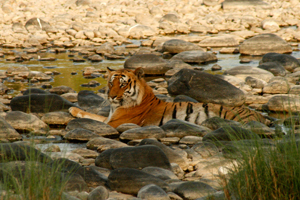Editorial: TigerLink, May 2014
It is difficult to focus on anything other than the elections now, given that we are in the midst of this exciting ‘event’. Looking from the perspective of wildlife conservation, it has been worrying, given that wildlife found scant mention in the electoral debate or party manifestos—a subject amply discussed in this TigerLink. So, I will move the debate forward and focus on what one can expect from 16th May, when the results are announced.
Given the way the wind is blowing, with major political parties in the fray using a business/investment friendly governance structure as an election fray, I do not envisage a bright future.
The BJP wants to change the environment laws and regulations to suit and facilitate big business; while the Congress has taken to the grave the exemplary legacy of Indira Gandhi- who spearheaded the Wildlife Protection Act, Forest Conservation Act, and Project Tiger-pushing clearances for mines and other such ‘red-listed’ industry with little regard environment and wildlife, and the regulations governing them. The UPA’s second tenure saw three ministers at the helm of Environment & Forests—two unceremoniously removed as they were seen to be ‘green’ (though the clearance record during their tenure suggests otherwise). The last to take on the mantle of the Ministry of Environment & Forests, also has the oil ministry in his portfolio. Someone forgot to tell the incumbent government that oil and environment don’t mix. Or perhaps they knew that only too well…
So will wildlife be on the  priority of the next government—whoever and however it be? Or will forests be sacrificed for populist reasons and a race for—unsustainable—growth? Will we have a government with vision for a sustainable future, balancing ecology and economy, or will we continue with the philosophy of “destroy now, and worry about it later”?
priority of the next government—whoever and however it be? Or will forests be sacrificed for populist reasons and a race for—unsustainable—growth? Will we have a government with vision for a sustainable future, balancing ecology and economy, or will we continue with the philosophy of “destroy now, and worry about it later”?
The writing is on the wall… but still, I look for shards of hope. The Asiatic lions in Gujarat-a BJP ruled state-are focus of a tremendous conservation effort, and a poaching crisis that hit Gir in 2007, has become a model of tackling cases of poaching (even if the state fails to share ‘its’ pride!). During the nine year tenure of the Congress dominated United Progressive Alliance, the number of tiger reserves climbed from 29 to 45, (credit must equally go to the concerned state governments), besides an increased budget for the tiger, and an enhanced relocation package for communities within core critical tiger habitats to incentivise voluntary relocation.
Moving onto other issues, I would like to take the reader to reserves unknown…well, not really, but almost off the map, particularly in the political melee. Reserves like Manas in Assam, Palamu in Jharkhand, Satkosia in Orissa and Udanti-Sitanadi in Chhattisgarh. They are tiger reserves too… though not as celebrated as those closer to power centres. Here, tigers are not an easy photo-capture, nor an easy ‘sighting.’, and in some their numbers have been questioned. But, they are part of vast, high potential tiger landscapes, significant fragments of just two percent of tiger habitat that remains in the country and harbour other rare species. Yet, they struggle with acute shortage of manpower, uninterested governments…a few are under siege of insurgency, and saddled with dispirited leadership. So will we write them off? Because it is easier to shrug off responsibility? Or will we take them on as a challenge, and turn them around, making them examples like NSTR which has clawed its way back to recovery or Panna which shed the shame of local extinction to nurture a ‘new’ tiger population, even feeding tigers to other reserves today?
The choice is ours to make. I hope we will have the wisdom and the vision to conserve, rather than allow deterioration and death by apathy.
Kanha & Corbett, Ranthambhore & Nagarhole, Dudhwa & Kaziranga were not made in a day-they are the result of decades of concerted effort, grit and commitment.
Last week, I spent time in Sitabani, part of the Ramnagar Forest Division, contiguous to Corbett Tiger Reserve. We narrowly missed sighting a tiger, but those with us who took a different path had an experience that last nearly an hour. Next morning I ran into elephants and strident alarm calls raised hopes…
The NTCA-WII estimates show a tiger density of 13 tigers/100 sq km here and camera traps have revealed breeding tigresses. With tiger densities higher than many reserves in the country and as a crucial link in the important Shivalik Gangetic landscape, it baffles the mind why Ramnagar Forest Division has failed to get a tiger reserve status.
Lack of a PA status has deprived the wildlife here of funding and technical support, its staff must also engage in commercial forestry, and not be deployed for concerted focus the protection of endangered wild creatures. Besides, without a PA status, the vulnerability of a forest to mining and other such destructive projects is greater.
Yes, it isn’t Corbett, but the tigers don’t know that…and surely, they deserve as much protection, as much of a safe future as a tiger within the boundaries of a reserve?